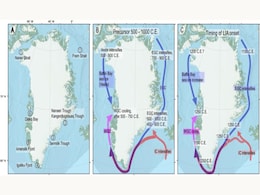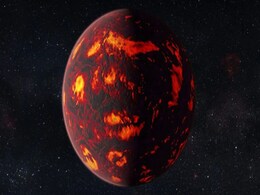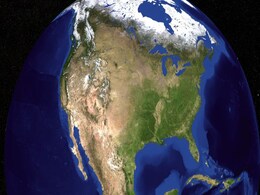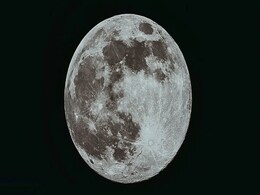Geological Study
- All
- News
- Videos
-

Water on Ancient Mars? New Study Challenges the Cold Planet Theory
- Saturday April 26, 2025
- Written by Gadgets 360 Staff
Scientists have uncovered compelling evidence suggesting that early Mars was surprisingly wet, featuring extensive networks of lakes and river basins shaped by rainfall and snowfall. This challenges long-held views of a predominantly cold and icy ancient Mars. Despite current climate models struggling to explain sustained liquid water on the Red Pl...
-
 www.gadgets360.com
www.gadgets360.com
-

Ancient Greenland Rocks Found in Iceland Sheds Light on Late Antique Ice Age
- Wednesday April 23, 2025
- Written by Gadgets 360 Staff
A 2025 study led by geologists Christopher Spencer, Ross Mitchell, and Thomas Gernon identifies ancient Greenland rocks embedded in Icelandic cliffs. These rocks, transported by icebergs over 1500 years ago, confirm glacial expansion during the Late Antique Little Ice Age (LALIA). The findings shed light on past climate anomalies and serve as cruci...
-
 www.gadgets360.com
www.gadgets360.com
-

Silent Chernobyl Incident of Aral Sea Caused Earth’s Mantle to Bulge the Land, Study Finds
- Saturday April 19, 2025
- Written by Gadgets 360 Staff
The desiccation of the Aral Sea led to the water being divided into two parts. The study reveals that the land beneath the sea is lifting every year, causing the Earth’s mantle to bulge up over the next few years.
-
 www.gadgets360.com
www.gadgets360.com
-

Earth’s Mantle Could Be Harbouring Ocean of Magma Formed Billions of Years Ago, Claims Study
- Thursday April 17, 2025
- Written by Gadgets 360 Staff
The study conducted by Boukaré and published on March 26 in the Journal Nature suggests that this molten layer at the core-mantle boundary of the Earth formed the internal thermal structure of the planet and tectonic plates. This may still influence the geochemical process of the Earth today. Further, it suggests a similar magma ocean existence on...
-
 www.gadgets360.com
www.gadgets360.com
-

Farallon Slab Beneath Midwest Pulls Crust Downward, Causing Widespread Thinning
- Saturday April 12, 2025
- Written by Gadgets 360 Staff
A tectonic slab buried 660km beneath the central US is pulling surface materials downward, causing the Earth's crust to thin across a wide region. The slab, a remnant of the Farallon plate, has been identified through seismic imaging and simulations as the cause of this geological activity. Researchers say this underground movement extends beyond t...
-
 www.gadgets360.com
www.gadgets360.com
-

1 Trillion Species, 3 Billion Years: AI Helped Trace Bacteria Evolution On Earth
- Friday April 4, 2025
- World News | The Conversation
Bacteria consist of a single cell. They do not have bones and are not like big animals that leave clear signs in the geological record, which thankful palaeontologists can study many millions of years later.
-
 www.ndtv.com
www.ndtv.com
-

Seafloor Spreading Slowdown May Have Caused 26–32m Sea Level Drop Over Millions of Years
- Wednesday March 5, 2025
- Written by Gadgets 360 Staff
Between 15 million and 6 million years ago, ocean crust production declined by 35 percent, leading to deeper ocean basins. This geological shift is believed to have caused a sea level drop of 26–32 meters. Research suggests that heat transfer from the mantle to the ocean decreased by 8 percent, potentially altering ocean chemistry. Some studies i...
-
 www.gadgets360.com
www.gadgets360.com
-

Solar System’s Journey Through Orion Complex May Have Altered Earth’s Climate
- Monday March 3, 2025
- Written by Gadgets 360 Staff
Scientists have studied the solar system’s passage through the Orion complex, a dense region in space, around 14 million years ago. According to researchers, this movement may have compressed the heliosphere and increased interstellar dust reaching Earth. This dust could have influenced the planet’s climate and left traces in geological records...
-
 www.gadgets360.com
www.gadgets360.com
-

New Seismic Data Challenges Earth's Inner Core Structure, Reveals Surprising Findings
- Wednesday February 19, 2025
- Written by Gadgets 360 Staff
Recent seismic data from 121 earthquakes recorded over three decades challenges previous beliefs about Earth's inner core. Researchers from the University of Southern California discovered structural changes in the core, suggesting it may not be as solid as once thought. These anomalies, observed while studying the core's slowing rotation, could of...
-
 www.gadgets360.com
www.gadgets360.com
-

Perseverance Rover Examines Serpentine Lake on Mars, Seeking Clues on Past Water Presence
- Wednesday February 19, 2025
- Written by Gadgets 360 Staff
NASA’s Perseverance rover has closely studied the rock formation known as Serpentine Lake on Mars, which reveals serpentine minerals that typically form in water-rich environments. The analysis aims to uncover clues about Mars' geological history and potential past habitability. Despite challenges in extracting samples from other sites, such as C...
-
 www.gadgets360.com
www.gadgets360.com
-

Moon's Geological Activity: New Evidence Suggests Surface Changes Persist
- Tuesday February 11, 2025
- Written by Gadgets 360 Staff
New research suggests the Moon may still be geologically active, as 266 newly discovered wrinkle ridges indicate recent surface changes. The study estimates these ridges formed within the last 160 million years, challenging the belief that lunar activity ended billions of years ago. Scientists believe continued contraction could cause moonquakes, p...
-
 www.gadgets360.com
www.gadgets360.com
-

Romania’s ‘Living’ Rocks Expand and Multiply in a Strange Natural Process
- Monday February 10, 2025
- Written by Gadgets 360 Staff
Trovants, mysterious geological formations found in Romania’s Costești region, are known for their unique ability to grow and multiply. These rocks, formed millions of years ago due to seismic activity, consist of a hard stone core surrounded by a porous sandstone shell. When rainwater rich in minerals like calcium carbonate seeps into the rock,...
-
 www.gadgets360.com
www.gadgets360.com
-

Moon’s Deepest Canyons Formed in Minutes by High-Speed Impact Debris
- Friday February 7, 2025
- Written by Gadgets 360 Staff
Reports reveal that two gigantic canyons on the moon, deeper than the Grand Canyon, were formed in under ten minutes due to the rapid movement of rock debris following the impact that created Schrödinger basin. These canyons, Vallis Schrödinger and Vallis Planck, were carved by debris traveling at speeds of up to 4,600 km/h. Scientists suggest th...
-
 www.gadgets360.com
www.gadgets360.com
-

Upheaval Dome: Utah’s Mysterious Crater That Still Puzzles Scientists
- Thursday February 6, 2025
- Written by Gadgets 360 Staff
Upheaval Dome in Utah, a rock formation with ridged, concentric circles, continues to spark debate among scientists. Some believe it formed due to a meteorite impact 60 million years ago, citing the presence of shocked quartz crystals. Others argue that underground salt deposits pushed upward, creating the structure. While the impact hypothesis has...
-
 www.gadgets360.com
www.gadgets360.com
-

New Study Finds Active Lunar Tectonics, Challenges Moon’s Dormancy
- Friday January 31, 2025
- Written by Gadgets 360 Staff
A recent study published in The Planetary Science Journal reveals that the moon is still experiencing tectonic activity. Scientists identified 266 small ridges on the far side of the moon, formed within the last 160 to 200 million years. The study suggests these ridges result from geological forces like lunar shrinking and orbital shifts. The findi...
-
 www.gadgets360.com
www.gadgets360.com
-

Water on Ancient Mars? New Study Challenges the Cold Planet Theory
- Saturday April 26, 2025
- Written by Gadgets 360 Staff
Scientists have uncovered compelling evidence suggesting that early Mars was surprisingly wet, featuring extensive networks of lakes and river basins shaped by rainfall and snowfall. This challenges long-held views of a predominantly cold and icy ancient Mars. Despite current climate models struggling to explain sustained liquid water on the Red Pl...
-
 www.gadgets360.com
www.gadgets360.com
-

Ancient Greenland Rocks Found in Iceland Sheds Light on Late Antique Ice Age
- Wednesday April 23, 2025
- Written by Gadgets 360 Staff
A 2025 study led by geologists Christopher Spencer, Ross Mitchell, and Thomas Gernon identifies ancient Greenland rocks embedded in Icelandic cliffs. These rocks, transported by icebergs over 1500 years ago, confirm glacial expansion during the Late Antique Little Ice Age (LALIA). The findings shed light on past climate anomalies and serve as cruci...
-
 www.gadgets360.com
www.gadgets360.com
-

Silent Chernobyl Incident of Aral Sea Caused Earth’s Mantle to Bulge the Land, Study Finds
- Saturday April 19, 2025
- Written by Gadgets 360 Staff
The desiccation of the Aral Sea led to the water being divided into two parts. The study reveals that the land beneath the sea is lifting every year, causing the Earth’s mantle to bulge up over the next few years.
-
 www.gadgets360.com
www.gadgets360.com
-

Earth’s Mantle Could Be Harbouring Ocean of Magma Formed Billions of Years Ago, Claims Study
- Thursday April 17, 2025
- Written by Gadgets 360 Staff
The study conducted by Boukaré and published on March 26 in the Journal Nature suggests that this molten layer at the core-mantle boundary of the Earth formed the internal thermal structure of the planet and tectonic plates. This may still influence the geochemical process of the Earth today. Further, it suggests a similar magma ocean existence on...
-
 www.gadgets360.com
www.gadgets360.com
-

Farallon Slab Beneath Midwest Pulls Crust Downward, Causing Widespread Thinning
- Saturday April 12, 2025
- Written by Gadgets 360 Staff
A tectonic slab buried 660km beneath the central US is pulling surface materials downward, causing the Earth's crust to thin across a wide region. The slab, a remnant of the Farallon plate, has been identified through seismic imaging and simulations as the cause of this geological activity. Researchers say this underground movement extends beyond t...
-
 www.gadgets360.com
www.gadgets360.com
-

1 Trillion Species, 3 Billion Years: AI Helped Trace Bacteria Evolution On Earth
- Friday April 4, 2025
- World News | The Conversation
Bacteria consist of a single cell. They do not have bones and are not like big animals that leave clear signs in the geological record, which thankful palaeontologists can study many millions of years later.
-
 www.ndtv.com
www.ndtv.com
-

Seafloor Spreading Slowdown May Have Caused 26–32m Sea Level Drop Over Millions of Years
- Wednesday March 5, 2025
- Written by Gadgets 360 Staff
Between 15 million and 6 million years ago, ocean crust production declined by 35 percent, leading to deeper ocean basins. This geological shift is believed to have caused a sea level drop of 26–32 meters. Research suggests that heat transfer from the mantle to the ocean decreased by 8 percent, potentially altering ocean chemistry. Some studies i...
-
 www.gadgets360.com
www.gadgets360.com
-

Solar System’s Journey Through Orion Complex May Have Altered Earth’s Climate
- Monday March 3, 2025
- Written by Gadgets 360 Staff
Scientists have studied the solar system’s passage through the Orion complex, a dense region in space, around 14 million years ago. According to researchers, this movement may have compressed the heliosphere and increased interstellar dust reaching Earth. This dust could have influenced the planet’s climate and left traces in geological records...
-
 www.gadgets360.com
www.gadgets360.com
-

New Seismic Data Challenges Earth's Inner Core Structure, Reveals Surprising Findings
- Wednesday February 19, 2025
- Written by Gadgets 360 Staff
Recent seismic data from 121 earthquakes recorded over three decades challenges previous beliefs about Earth's inner core. Researchers from the University of Southern California discovered structural changes in the core, suggesting it may not be as solid as once thought. These anomalies, observed while studying the core's slowing rotation, could of...
-
 www.gadgets360.com
www.gadgets360.com
-

Perseverance Rover Examines Serpentine Lake on Mars, Seeking Clues on Past Water Presence
- Wednesday February 19, 2025
- Written by Gadgets 360 Staff
NASA’s Perseverance rover has closely studied the rock formation known as Serpentine Lake on Mars, which reveals serpentine minerals that typically form in water-rich environments. The analysis aims to uncover clues about Mars' geological history and potential past habitability. Despite challenges in extracting samples from other sites, such as C...
-
 www.gadgets360.com
www.gadgets360.com
-

Moon's Geological Activity: New Evidence Suggests Surface Changes Persist
- Tuesday February 11, 2025
- Written by Gadgets 360 Staff
New research suggests the Moon may still be geologically active, as 266 newly discovered wrinkle ridges indicate recent surface changes. The study estimates these ridges formed within the last 160 million years, challenging the belief that lunar activity ended billions of years ago. Scientists believe continued contraction could cause moonquakes, p...
-
 www.gadgets360.com
www.gadgets360.com
-

Romania’s ‘Living’ Rocks Expand and Multiply in a Strange Natural Process
- Monday February 10, 2025
- Written by Gadgets 360 Staff
Trovants, mysterious geological formations found in Romania’s Costești region, are known for their unique ability to grow and multiply. These rocks, formed millions of years ago due to seismic activity, consist of a hard stone core surrounded by a porous sandstone shell. When rainwater rich in minerals like calcium carbonate seeps into the rock,...
-
 www.gadgets360.com
www.gadgets360.com
-

Moon’s Deepest Canyons Formed in Minutes by High-Speed Impact Debris
- Friday February 7, 2025
- Written by Gadgets 360 Staff
Reports reveal that two gigantic canyons on the moon, deeper than the Grand Canyon, were formed in under ten minutes due to the rapid movement of rock debris following the impact that created Schrödinger basin. These canyons, Vallis Schrödinger and Vallis Planck, were carved by debris traveling at speeds of up to 4,600 km/h. Scientists suggest th...
-
 www.gadgets360.com
www.gadgets360.com
-

Upheaval Dome: Utah’s Mysterious Crater That Still Puzzles Scientists
- Thursday February 6, 2025
- Written by Gadgets 360 Staff
Upheaval Dome in Utah, a rock formation with ridged, concentric circles, continues to spark debate among scientists. Some believe it formed due to a meteorite impact 60 million years ago, citing the presence of shocked quartz crystals. Others argue that underground salt deposits pushed upward, creating the structure. While the impact hypothesis has...
-
 www.gadgets360.com
www.gadgets360.com
-

New Study Finds Active Lunar Tectonics, Challenges Moon’s Dormancy
- Friday January 31, 2025
- Written by Gadgets 360 Staff
A recent study published in The Planetary Science Journal reveals that the moon is still experiencing tectonic activity. Scientists identified 266 small ridges on the far side of the moon, formed within the last 160 to 200 million years. The study suggests these ridges result from geological forces like lunar shrinking and orbital shifts. The findi...
-
 www.gadgets360.com
www.gadgets360.com

















